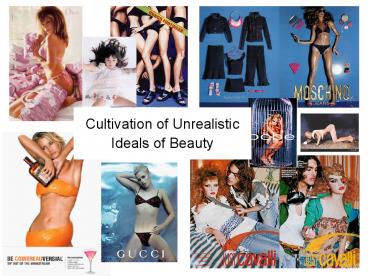Cultivation of Unrealistic Ideals of Beauty - PowerPoint PPT Presentation
1 / 18
Title:
Cultivation of Unrealistic Ideals of Beauty
Description:
Males viewed 16 s from Playboy & Penthouse. Control viewed 16 s of abstract art. ... Television Cartoons: Do Children Notice It's a Boy's World. ... – PowerPoint PPT presentation
Number of Views:672
Avg rating:3.0/5.0
Title: Cultivation of Unrealistic Ideals of Beauty
1
Cultivation of Unrealistic Ideals of Beauty
2
Unrealistic Body Images
- If Barbie was human sized, she would stand 5 foot
7 inches tall, weigh 110 pounds, have a 39 inch
bust, 17 inch waist and 33 inch hips. - A cat of average size has a waist size of around
15.5 inches.
3
Women in the Reel World v. Real World
Average American Woman 54 140lb
Average Model 510 110 120lb
4
Cultivation Theory
- People who watch a lot of television tend to see
the real world in terms of the images, values,
portrayals and ideologies that emerge through the
lens of television. - Cultivation is not unidirectional but more like a
gravitational pull depending on message,
audience, and context. - Cultivation differential
- The margin of difference in conceptions of
reality between light and heavy viewers, assuming
all other demographic variables are equivalent. - Mainstreaming
- dominant structure of attitudes beliefs values
and practices - Television is/was the primary channel of the
mainstream of American culture - Heavy viewing may override differences in
perspectives and behavior that ordinarily stem
from other factors and influences. - How?
- Availability (cognitive shortcut info that is
more readily available in mind, is more likely to
be used) - People forget the source of information (sleeper
effect). - Cultivation research during an era in television
history dominated by a few channels, today more
media choices, interactivity viewer control.
5
Field, Cheung, Wolf, Herzog, Gortmaker Colditz,
1999
- Pictures in magazines had a strong impact on
girls' perceptions of their weight and shape. - Of the girls, 69 reported that magazine pictures
influence their idea of the perfect body shape,
and 47 reported wanting to lose weight because
of magazine pictures.
6
(No Transcript)
7
Paxton, Wertheim, Gibbons, Szmukler, Hillier,
Petrovich, 1991
- In a sample of male and female high school
students, two-thirds of boys and girls believed
that being thinner would have an impact on their
lives. The majority of girls believed that this
impact would be positive, while the majority of
the boys believed that the impact would be
negative. - Girls had higher body dissatisfaction scores than
boys on all measures. - Girls reported magazines as their primary source
of information regarding diet and health, whereas
boys reported their primary source to be parents,
followed by two other categories before
mentioning magazines.
8
Becker and Burwell, 1999
- IN FIJI, gaining weight used to be a sign of good
health and attractiveness. - Since Western television arrived in 1995, Harvard
researchers have discovered a new trend of
bulimia, anorexia, and Western-style dieting
among adolescent Fijian girls. - girls who watched television three or more nights
a week were 50 more likely to say they were "too
big or fat," and 30 likelier to diet. - In a 1998 survey, 15 of girls said they had
tried to control their weight by vomiting. - Among the most popular programs are "Melrose
Place," "Beverly Hills, 90210," and "Seinfeld."
9
Obsession with Thinness
- over 90 of patients with anorexia nervosa or
bulimia nervosa are women (American Psychiatric
Association, 1994) - The diet industry is estimated at 40 billion and
growing.
10
The number of plastic surgery patients has
steadily increased 153 from 1992-1998. The
overwhelming majority of patients (91) is female
11
Focus on Womens Appearance
- Content Analysis of Women Media (Signorelli,
1997) - 58 of female characters in movies had comments
made about their looks, as did 28 in television
shows and 26 of the female models in the
accompanying commercials. - Mens' and boys' appearance is talked about
significantly less in all three media a quarter
(24) of male characters in the movies, 10 7,
respectively, in television shows and
commercials. - 37 of articles in leading teen girl magazines
included a focus on appearance - most of the
advertisements (50) used an appeal to beauty to
sell their products. - Commercials aimed at female viewers that ran
during television shows most often watched by
teen girls frequently used beauty as a product
appeal (56 of commercials). - This is true of just 3 of television commercials
aimed at men.
12
Focus on Womens Appearance
- Women earn more money than men in only two job
categories modeling and prostitution (Wolf,
1992).
13
Contrast Effect
14
Contrast Effect in Real Life
15
Influence of popular erotica on judgments of
strangers and mate
- All participants were married or in a live-in
relationship, randomly assigned to 3 conditions - Females viewed 16 slides from Playgirl
- Males viewed 16 slides from Playboy Penthouse.
- Control viewed 16 slides of abstract art.
- Subjects asked to rate aesthetic appeal of the
slides, and afterwards to rate their satisfaction
with current relationship.
Kenrick, D.T., Gutierres, S.E., Goldberg, L.L.,
(1989). Influence of popular erotica on judgments
of strangers and mates. Journal of Experimental
Social Psychology , 25 (2), 159-167.
16
Influence of popular erotica on judgments of
partners sexual attractiveness
17
Influence of popular erotica on judgments of love
for partner
18
Readings for Next Class
- Davies, P., Spencer, S., Quinn, D.,
Gerhardstein, R. (2002). Consuming images How
television commercials that elicit stereotype
threat can restrain women academically and
professionally. Personality and Social Psychology
Bulletin , 28 , 1615-1628. - Thompson, Teresa L. and Zebrinos, Eugenia.
(1997). Television Cartoons Do Children Notice
It's a Boy's World. Sex Roles A Journal of
Research 37 415 - 428.































